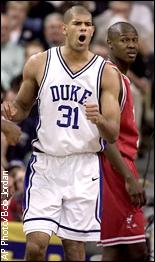Lack of upsets doesn't mean quality is down
By Andy Katz
ESPN.com
All but three of the top 32 seeds advanced to the second round of
the NCAA Tournament, but don't think that means the selection committee
wasted its time creating the bracket.
What did we learn after two days? That the committee did a decent
job of putting together a lively tournament, even if there were technically only three upsets. Three others were a possession away, but that would have only made this more of an unpredictable tournament, not necessarily a better one.
|  | | Shane Battier and Duke battered Lamar as expected. |
So what if at this point last season, 12 teams in the bottom half of the draw (four 9s, four 10s, two 12s, a 13 and a 14) had advanced to the second round? Taking out the four No. 1 seeds, the average point differential this year was 11.11. Last year? 11.79. Across the board, the games are just as close.
What about single-digit margins, you ask? This year's tourney has had 13 so far, compared to 12 last season. One-point victories? Three in 2000, two in 1999.
The committee should be commended for putting together competitive games that gave us four overtime matchups (compared to one in last year's opening round) and two gems out of the 4-13 matchups Tennessee over Louisiana and LSU over Southeast Missouri State.
There wasn't a 5-12 upset for the first time since 1988, but two of
those matchups went into overtime (Butler falling to Florida and St.
Bonaventure's double-overtime thriller against Kentucky). The 7-10 matchups were all as
tight as expected, with two upsets (in seeding only) as Seton Hall beat
Oregon and Gonzaga took out Louisville.
The 8 vs. 9 matchup of Kansas and DePaul didn't disappoint. The
Blue Demons blew a chance to finish off the Jayhawks in regulation and
then failed to tie the game on a Quentin Richardson jumper.
The top seeds were protected, as they should be in the first round,
giving all four the requisite free pass to the second round. But the committee didn't do three of the four
any favors, matching them up against extremely tough and unusual eight seeds
in North Carolina (for Stanford), Kansas (for Duke) and Wisconsin (for
Arizona). If Utah were healthy, the Utes would fit a similar profile against the
Spartans.
None of the top four showed any flaws in the first round, but that
could change dramatically in tighter second-round games. In fact, expect the second round to be better than years past because the teams will be more evenly matched. Few, if any, will be cakewalks for the higher seed into the Sweet 16.
The rest of the top seeds held true to form in the South and East
on Friday, starting with No. 3 Oklahoma State dismantling Hofstra, setting up a potential
upset game against No. 11 Pepperdine (the lowest seed remaining). Temple's
defense was dominant against Lafayette, showing what most expected in that the Owls are the most dangerous No. 2 seed out there. Cincinnati, thought to be a wounded animal
without Kenyon Martin, got an easy win against UNC Wilmington to prepare for
No. 7 Tulsa, which pummeled UNLV.
Ohio State cruised. Miami struggled to put away Arkansas.
Connecticut kept its back-to-back national title hopes alive, although they strongly hinge on Khalid
El-Amin's injured ankle -- and if it keeps him out of Sunday's game against Tennessee. And if you're looking for an upset special down the line, Illinois emerged as a darkhorse threat to knock off Duke, provided it can get past Florida.
Andy Katz is a senior writer at ESPN.com.
|


